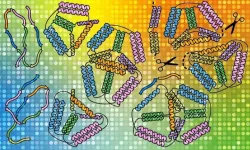(Press-News.org) Researchers from the National Institutes of Health have identified and tested a drug combination that exploits a weakness in small cell lung cancer (SCLC), an aggressive, dangerous cancer. The scientists targeted a vulnerability in how the cancer cells reproduce, increasing already high levels of replication stress ¬¬-- a hallmark of out-of-control cell growth in many cancers that can damage DNA and force cancer cells to constantly work to repair themselves. In a small clinical trial, the drug duo shrank the tumors of SCLC patients. The team reported its findings April 12 in Cancer Cell.
While many patients with small cell lung cancer initially respond to chemotherapy, they lack an effective follow-up treatment. These patients usually live a matter of weeks after their first treatment stops working and their disease returns. Scientists at NIH's National Cancer Institute (NCI) and National Center for Advancing Translational Sciences (NCATS) teamed up to find another option to treat these cancers, which are part of a larger group of similar diseases called small cell neuroendocrine cancers.
"We wanted to identify novel drugs and combinations to leverage this vulnerability therapeutically," said NCI's Anish Thomas, M.D., who led the study. "We saw potential opportunities because the armamentarium of new chemicals and drugs was rapidly expanding."
The NCI group collaborated with NCATS co-author Craig Thomas, Ph.D., and his team to use NCATS' matrix screening platform and expertise to explore the potential of nearly 3,000 agents from an oncology-focused library of investigational and approved drugs against SCLC cells in the laboratory.
NCATS' robotics-enabled, high-throughput screening technologies allow scientists to rapidly test thousands of different drugs and drug combinations in a variety of ways. Scientists can examine the most promising drugs and drug combinations, determine the most effective doses of each drug and learn more about the possible mechanisms by which these drugs act.
The research team found multiple drug combinations involving commonly used chemotherapy drugs that cause DNA damage and drugs designed to block DNA repair. One of the most effective combinations was the U.S. Food and Drug Administration-approved chemotherapy drug topotecan and an investigational drug M6620, or berzosertib, which blocks an enzyme, called ATR, that plays a role in DNA repair.
"A lot of exciting advances have led to the clinical availability of ATR inhibitors, including berzosertib," said NCATS translational scientist Michele Ceribelli, Ph.D., a co-author. "Blocking the ATR enzyme means cancer cells can't respond to DNA damaging agents properly. This makes chemotherapy even more effective."
The NCI researchers tested the berzosertib-topotecan drug combination in a clinical trial involving SCLC patients who either had relapsed after initial treatment or for whom their therapy had stopped working. They found that the drug combination helped more than one-third of participants (9 of 25) improve in some way. In some cases, the improvement lasted for six months.
"There are a lot of unknowns within the translational process," said Craig Thomas. "Such large combination screening experiments can reveal pharmacologic relationships from an increasingly diverse collection of compounds and drugs. In the best-case scenario, the outcomes of these screens can help clinical teams prioritize their efforts."
When the scientists looked more closely at the tumor samples, they discovered that the patients whose tumors became smaller in response to treatment showed more activity in genes involved in rapid cell growth and DNA repair. The findings suggest that researchers could develop a more personalized approach in treating SCLC patients as well as other types of small cell neuroendocrine cancers.
INFORMATION:
As a next step, NCI is sponsoring a larger clinical trial to compare the effects of berzosertib and topotecan in combination against topotecan alone in SCLC patients.
For more information about this clinical trial, visit: https://clinicaltrials.gov/ct2/show/NCT03896503
The work was supported by the intramural programs of the Center for Cancer Research, NCI (ZIA BC 011793) and the Division of Preclinical Innovation, NCATS.
About the National Center for Advancing Translational Sciences (NCATS): NCATS conducts and supports research on the science and operation of translation -- the process by which interventions to improve health are developed and implemented -- to allow more treatments to get to more patients more quickly. For more information about NCATS, visit https://ncats.nih.gov.
About the National Institutes of Health (NIH): NIH, the nation's medical research agency, includes 27 Institutes and Centers and is a component of the U.S. Department of Health and Human Services. NIH is the primary federal agency conducting and supporting basic, clinical, and translational medical research, and is investigating the causes, treatments, and cures for both common and rare diseases. For more information about NIH and its programs, visit https://www.nih.gov.
NIH...Turning Discovery Into Health®
A new test that measures the quantity and quality of inactive HIV viruses in the genes of people living with HIV may eventually give researchers a better idea of what drugs work best at curing the disease.
Currently no cure exists for HIV and AIDS, but antiretroviral therapy drugs, or ARTs, effectively suppress the virus to undetectable levels.
Published today in Cell Reports Medicine, the study discusses how a new test, developed jointly by scientists at the University of Washington School of Medicine and Fred Hutchinson Cancer Research Center, will ...
While pollinators such as bees and butterflies provide crucial ecosystem services today, little is known about the origin of the intimate association between flowering plants and insects.
Now, a new amber fossil unearthed by researchers from the Nanjing Institute of Geology and Palaeontology of the Chinese Academy of Sciences (NIGPAS) and the University of Bristol sheds light on some of the earliest pollinators of flowering plants.
The study was published in Nature Plants on April 12.
Two hundred million years ago the world was as green as today, overgrown with dense vegetation, but it was not as colorful. Flowering plants (angiosperms) that make up over 80% of all plant species today, only began to diversify in the Cretaceous, about 125 million years ago.
Some scientists have attributed ...
A new 160-million-year-old arboreal pterosaur species, dubbed 'Monkeydactyl', has the oldest true opposed thumb - a novel structure previously not known in pterosaurs.
An international team of researchers from China, Brazil, UK, Denmark and Japan have described a new Jurassic pterosaur Kunpengopterus antipollicatus, which was discovered in the Tiaojishan Formation of Liaoning, China.
It is a small-bodied darwinopteran pterosaur, with an estimated wingspan of 85 cm. Most importantly, the specimen was preserved with an opposed pollex ("thumb") on both hands.
The species name 'antipollicatus' ...
Singapore, 12 April 2021 - Researchers from the Low Energy Electronic Systems (LEES) Interdisciplinary Research Group (IRG) at Singapore-MIT Alliance for Research and Technology (SMART), MIT's research enterprise in Singapore, together with Massachusetts Institute of Technology (MIT) and National University of Singapore (NUS) have found a method to quantify the distribution of compositional fluctuations in the indium gallium nitride (InGaN) quantum wells (QWs) at different indium concentrations.
InGaN light emitting diodes (LEDs) have revolutionised the field ...
A new study conducted jointly by the Univerisyt of Liege (Belgium) and the University of Reading (England) suggests that 34% of the Antarctic ice shelves could disappear by the end of the century if the planet warms up by 4°C compared with pre-industrial temperatures. This melting could lead to a significant rise in sea levels. This study is published in the journal Geophysical Research Letters.
Since the early 2000s, scientists have observed that the Antarctic ice sheet is losing mass at a rate that is accelerating. The ice sheet is a very thick expanse of ice that can cover an entire continent. There are only two ice sheets on Earth: the Greenland ice sheet, which is limited to the ...
A shared set of systems in the brain may play an important role in controlling the retrieval of facts and personal memories utilised in everyday life, new research shows.
Scientists from the University of York say their findings may have relevance to memory disorders, including dementia, where problems remembering relevant information can impact on the daily life of patients.
Researchers say the findings may also have important implications for the development of a new generation of artificial intelligence systems, which use long-term memory in solving computational problems.
The brain's long-term memory stores are categorised into two: factual memory ...
Researchers at the University of Toronto have found that a calorie labelled is not the same as a calorie digested and absorbed, when the food source is almonds.
The findings should help alleviate concerns that almonds contribute to weight gain, which persist despite the widely recognized benefits of nuts as a plant-based source of protein, vitamins and minerals.
"Nuts have generally been thought of as healthy the last two decades, but the messaging around nuts has often come with a disclaimer that they are high in fat and energy," said John Sievenpiper, ...
Inland waters are an important component of the global carbon cycle and function as active reactors, transporting and transforming large quantities of naturally- and anthropogenically-derived carbon. Previous studies suggest that inland waters are major sources for greenhouse gas emissions to the atmosphere, yet these emissions are poorly constrained (Note 1).
As a primary greenhouse gas that drives global climate change, carbon dioxide (CO2) emissions from inland waters play a key role in assessing global carbon cycle. While most efforts over the last decade have focused on refining the emission flux estimates at the regional and global scales, scientists do not fully understand the responsiveness of regional ...
A recent study finds U.S. companies that have a substantial number of employees in foreign jurisdictions with lower tax rates are more likely than their peers to "artificially" locate earnings in those jurisdictions - and the Internal Revenue Service (IRS) is less likely to challenge these complex tax-planning activities.
"Many politicians seek to encourage domestic employment and discourage sending jobs overseas," says Nathan Goldman, co-author of the study and an assistant professor of accounting in North Carolina State University's Poole College of Management. "To do that, they'll need to address elements of corporate tax policy that effectively encourage ...
Origami may sound more like art than science, but a complex folding pathway that proteins use to determine their shape has been harnessed by molecular biologists, enabling them to build some of the most complex synthetic protein nanostructures to date.
Using EMBL Hamburg's world-class beamline P12 at DESY's PETRA III synchrotron, a team of Slovenian researchers, in collaboration with EMBL's Svergun group, directed powerful X-ray beams at artificial proteins called coiled-coil origami. The proteins were designed to fold into a particular shape based on short modules that interact ...




